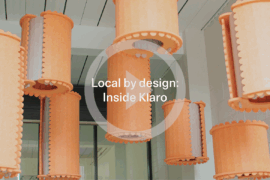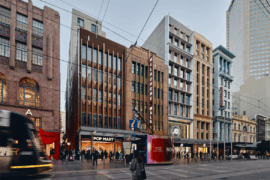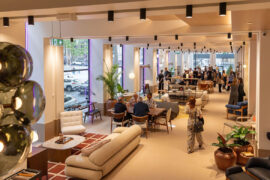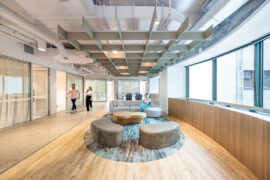Wood, ink, paper, leather – Ariake offers impeccably crafted furniture pieces designed by an international team with a unique Japanese twist. The brand is now available in Singapore from Grafunkt.

August 30th, 2017
Named after the Ariake Sea in Southern Japan, Ariake is a furniture brand owned by Legnatec and Hirata Chair – two factories from the furniture town of Morodomi in Saga prefecture, Japan.
The word ‘ariake’ means daybreak in Japanese, and symbolises a new beginning for the two factories as they collaborate not only with each other (Legnatec is a cabinet specialist and Hirata Chair a chair specialist) but also with a team of international designers.
The Ariake brand and inaugural collection were born from an intensive workshop in Morodomi. Legnatec and Hirata Chair engaged Singaporean designer Gabriel Tan, whom they met at IFFS last year, to form an international creative team to create a new collection for the international market.
This international team consists of furniture designers Tan, Espen Voll of Norwegian design studio Anderssen & Voll, Japanese architect Keiji Ashizawa, and Swedish designer Staffan Holm with Swiss design studio AnnerPerrin designing the branding and Swiss photographer Sebastian Stadler documenting the visuals.
The result of an eight-day intensive workshop in Morodomi is a collection of 18 furniture pieces that utilises the best of hand and machine (read more about the story of the collaboration here).
Inspired by the spirit of Japanese culture and urban living contexts, Ariake collection is very much international in taste, with a Japanese twist. The collection mixes wood both imported (white oak, ash, cedar) and native Japanese (hinoki), pairs them with leather, paper chord and unique finishes such as sumi ink, indigo and burnt cedar.
Indigo is used for a dark blue finish while burnt cedar brings a smoky effect. Made from candle soot, sumi ink (a common staple in Japanese painting) is used to dye the wood black without diminishing its natural grain like paint can. The availability of sumi in Japan has also made it a more economical choice than black paint, lending to a reasonable price point for the quality. Ariake is the first brand to use sumi for commercial production.
The Ariake collection is now available in Singapore from Grafunkt.
INDESIGN is on instagram
Follow @indesignlive
A searchable and comprehensive guide for specifying leading products and their suppliers
Keep up to date with the latest and greatest from our industry BFF's!

In an industry where design intent is often diluted by value management and procurement pressures, Klaro Industrial Design positions manufacturing as a creative ally – allowing commercial interior designers to deliver unique pieces aligned to the project’s original vision.

For a closer look behind the creative process, watch this video interview with Sebastian Nash, where he explores the making of King Living’s textile range – from fibre choices to design intent.

Merging two hotel identities in one landmark development, Hotel Indigo and Holiday Inn Little Collins capture the spirit of Melbourne through Buchan’s narrative-driven design – elevated by GROHE’s signature craftsmanship.

From city-making to craft, design heritage to material innovation, these standout interviews offered rare insight into the people steering architecture and design forward.

In an industry where design intent is often diluted by value management and procurement pressures, Klaro Industrial Design positions manufacturing as a creative ally – allowing commercial interior designers to deliver unique pieces aligned to the project’s original vision.
The internet never sleeps! Here's the stuff you might have missed

Stylecraft opens its new Collins Street showroom, unveiling curated design spaces and Ross Gardam’s Dwell collection.

Milliken’s ‘Reconciliation Through Design’ initiative is amplifying the voices of Aboriginal and Torres Strait Islander artists, showcasing how cultural collaboration can reshape the design narrative in commercial interiors.